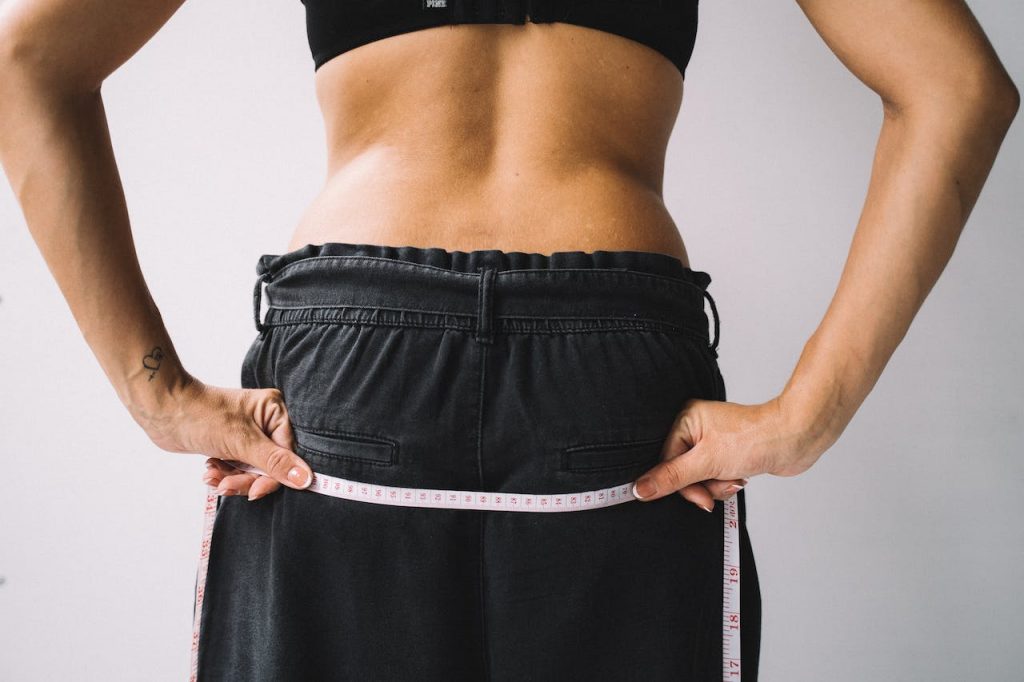Getting accurate body measurements, particularly in the case of hip measurements, can often pose a challenge due to factors like posture, the level of breath held while measuring, and even the tightness of the measuring tape. This difficulty has wide-ranging implications, particularly in clothing manufacturing and health industries. In the fashion industry, an estimated 40% of all online clothing returns are due to poor fit, a problem rooted in improper body measurements. In the health sector, inaccurate body measurements can lead to misleading Body Mass Index (BMI) calculations, affecting nearly 20% of health assessments. These statistics underline the importance of getting body measurements right first.
Among the many body measurements that cause confusion is the hip measurement, which is the circumference of the widest part of your hips and buttocks. It’s a crucial measurement for women, especially when buying skirts, dresses, and pants that fit well around the hips. Here are a few things to remember to get an accurate hip measurement every time.
How to Measure Your Hips
How to measure my hips will always be a question you’ll ask when buying clothes that fit well. Knowing how to measure your hips correctly is crucial for numerous reasons. It is not merely about fashion or ensuring your clothes fit perfectly; it is also about understanding your body type, vital for various exercises and diets tailored to specific shapes. Additionally, hip measurements are essential in injury prevention and sports and physical therapy rehabilitation.
To illustrate, consider a few examples of different hip types:
- Pear-shaped: People with wider hips than shoulders, also known as the pear shape. This body type is common among women and requires specific exercises targeting the lower body.
- Athletic build: Individuals with narrow hips, broad shoulders, a relatively flat stomach, and well-defined muscles on their limbs fall into this category. They require different training routines to achieve various fitness goals.
- Hourglass: This is when the hip and bust measurements are relatively equal, with a smaller waist; this body type requires more focus on core exercises, with a mix of upper and lower body training.
- Apple-shaped: Individuals in this category have broader shoulders than their hips, a larger midsection or belly, and narrower legs. Fitness goals for such individuals would require more fat-burning exercises and a balanced diet.
Different body shapes require different training regimens, which makes knowing your hip measurement crucial. Furthermore, inaccurate measurements could lead to injury or improper form during workouts.
Knowing how to measure hips will also be crucial when considering the clothing style. Some clothing styles are more suited to certain body types than others. For instance, someone with a pear-shaped body may want to avoid high-waisted pants or skirts that emphasize the hips and opt for A-line dresses instead. How to measure hips for pants will also change, especially when you want a pair that stretches or not. Here are a few to consider:
- High hips: High-hipped individuals have hip bones that protrude from their stomachs, giving the appearance of high-waisted pants. You might need help knowing how to measure high hips, so consult a tailor.
- Low hips: If you have low hips, your hip bones are below your love handles. This type of body is often referred to as having a pooch or muffin top. Avoid tight-fitting clothing around the waist to balance the proportions, and choose looser styles.
- Average hips: Most clothing styles should work well for those with average hips, but be mindful of your measurements to ensure the best fit.
Like body types, genders might also have different hip measurement methods. For instance, women are often told to stand with their feet together when measuring their hips, while men are instructed to stand with their feet shoulder-width apart. This difference is because of the varying hip structures between genders. You can learn how to measure hip size for men more easily, especially when using the proper technique for accurate results.
How Often Should You Measure Your Hips?
Hips can change due to various factors such as weight gain or loss, pregnancy, aging, or strength training targeting the hip region. For example, pregnancy and childbirth can cause a widening of the hips in women due to hormonal changes and the physical demands of delivery. Therefore, how to measure hips for females can be different. Aging can lead to a loss of muscle mass and redistribution of body fat that can change the size and shape of the hips. On the other hand, strength training can enlarge the hip muscles, resulting in broader hips.
Given these changes, tracking your hip measurements periodically is recommended. How often you should measure your hips largely depends on your health goals, body changes, or fitness program. If you’re actively trying to lose weight or working on bodybuilding, measuring your hips every two weeks is advisable. On the other hand, if your weight and shape are relatively stable, measuring once every few months should suffice.
The accuracy of hip measurements also depends on where to take hip measurements. The correct place is the widest part of your buttocks. Ensure the measuring tape is parallel to the floor and not twisted. Stand before a mirror to ensure you’ve placed the measuring tape correctly. Moreover, maintaining the same position each time you measure can help achieve consistent results. This method is universally applicable whether you are figuring out how to take hip measurements for men or women. Consistency and accuracy are crucial to getting your hip measurement right every time.
Can Hip Measurements Change Over Time?
Yes, hip measurements can change over time due to various factors. Understanding these factors can be biological, lifestyle-related, or both is important. They contribute to changes in our body shape, including the hip area, and can influence the fit of our clothing, comfort level, and overall self-perception.
- Aging: As people age, their body composition naturally changes. Muscle mass often decreases, and body fat increases and redistributes around the body, including the hips.
- Pregnancy: Pregnancy significantly impacts a woman’s body. The body releases hormones that allow the hip joints to relax and the hips to widen in preparation for childbirth. Some women may experience permanent changes in their hip measurements post-pregnancy.
- Weight fluctuation: Weight changes also result in changes in hip measurements. Gaining weight often increases hip size, whereas losing weight generally results in a decrease.
- Exercise and training: Specific exercises can impact hip size by building muscle or burning fat. Strength training, for example, can make the gluteus muscles, leading to wider hips. Conversely, cardio workouts can help shed fat, potentially reducing hip size.
- Hormonal changes: Hormones play a significant role in fat distribution in people’s bodies. Changes in hormone levels due to menopause, for example, can increase fat storage in the hip area.
- Genetics: Genes influence body shape and hip size. You will likely have wider hips if wider hips run in your family.
Understanding why hip measurements change helps you stay ahead of these changes, ensuring you measure your hips accurately and regularly. It also allows you to adjust your training or diet and choose clothing styles that flatter your changing body shape.
Benefits of Finding Your Perfect Fit
Knowing your accurate hip measurement and finding the perfect fit has multiple benefits, spanning the spheres of comfort, aesthetics, and health.
- Comfort: Wearing clothes perfectly fitting your hip measurement ensures comfort throughout the day. Clothes that are too tight might restrict movement and cause discomfort, whereas those that are too loose may require constant adjustments and make you feel less secure in your outfit.
- Aesthetics: Clothes that fit well enhance your body’s natural shape and can help you feel more confident in your appearance. Regardless of the current fashion trends, a well-fitted outfit always makes a solid style statement.
- Health: Ill-fitting clothes, particularly those that are too tight, can cause health issues. For instance, tight pants can lead to problems like decreased circulation, nerve impingement, and even digestive issues. Therefore, knowing the exact measurement of your hips can help you avoid such health-related issues.
- Cost-effective: An accurate hip measurement can save you money in the long run. It eliminates the need for constant clothing adjustments and reduces the likelihood of online shopping returns due to poor fit.
You will know that you’ve found the perfect fit through your hip measurements when your clothes feel comfortable all day long, enhance your natural body shape without discomfort, and don’t restrict your movement. Your clothes should fit snugly but not so tight that they cause pain or difficulty moving. You should be able to sit, stand, and walk easily without feeling any pinch or tightness. If you’re shopping online, you’re choosing the correct sizes if you find a decrease in the need for returns due to ill-fitting items. The perfect fit should make you feel confident and comfortable in your skin.
How to Measure Your Waist-to-Hip Ratio
The waist-to-hip ratio (WHR) is valuable for understanding your body shape and assessing associated health risks. To calculate this, first measure your waist circumference at its most minor point, usually just above the belly button. For the hip measurement, find the widest part of your hips and buttocks, as outlined in the how to measure hips section. Once you have these measurements, divide the waist circumference by the hip measurement. The number you get is your WHR.
This ratio is helpful for more than just clothing fit. It’s a quick and easy way to understand the fat distribution in your body, with higher ratios indicating more belly fat. Health professionals often use this metric to assess the risk of health conditions such as type 2 diabetes and heart disease. High waist-to-hip ratios can indicate a higher risk of these health problems, particularly in women with a WHR of 0.85 or higher and men with a WHR of 1.0 or higher. Therefore, knowing how to measure hip size and waist size accurately is essential for more than just perfect-fitting clothes; it is also pivotal in maintaining good health.
Regularly measuring your WHR alongside your hip measurements can provide a more comprehensive view of your changing body shape, allowing you to make more informed decisions about your diet, exercise, and lifestyle. Remember, while body measurements are helpful health indicators, they are just one aspect of wellness. Always consult with a healthcare professional for a comprehensive understanding of your health.
Tips and Techniques of Taking Hip Measurement
You will need a flexible measuring tape to take your hip measurement. Follow these steps:
- Stand upright: Stand in front of a mirror with your feet close together for the most accurate measurement. Correct positioning is vital to getting your hip measurement right.
- Identify the widest part of your hips: The widest part is usually the fullest part of your buttocks. This is where the hips are measured.
- Wrap the measuring tape around your hips: Ensure the tape is flat against your skin and parallel to the floor around your body. Avoid pulling the measuring tape too tight; it should be snug but not digging into your skin.
- Read and record your measurement: Look in the mirror to read the tape measurement at the point where the tape meets the zero end. This number is your hip size.
Remember, consistency is critical when measuring your hips. Always measure at the same spot to track your changes accurately over time. If you have difficulty taking the measurement yourself, you may want to ask someone for help, at least for the first few times. This guide should help you understand what your hip size is and how to measure your hips correctly.
The most important thing is to ensure you’re measuring in the correct place and not adjusting the tape too tightly or too loosely. Once you’ve mastered the technique, you can answer the question, “What is my hip size?” confidently and accurately.
Final Thoughts
Knowing how to measure hip size is essential for finding the perfect fit when shopping for clothes, ensuring comfort throughout the day, and maintaining good health. It also helps you understand your body shape and changes over time, allowing you to make informed decisions about your diet, exercise routine, and clothing styles that flatter your figure. Remember to measure consistently and accurately for the best results. With these tools and techniques, you can always ensure you’re getting the right fit.
FAQs
What is the normal hip size?
Average hip size varies significantly from person to person, depending on factors like body type, gender, and genetics. There’s no “normal” or average hip size that applies to everyone. It’s essential to know your measurements for clothing fit and health assessments.
What is a normal hip-to-waist ratio?
A healthy waist-to-hip ratio differs between genders. For men, a healthy ratio is typically considered to be 0.9 or less, while for women, it’s 0.85 or less. However, these numbers can vary based on ethnicity and individual health circumstances.









